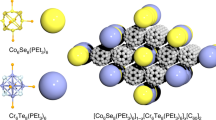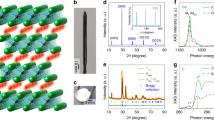Abstract
ELECTRIDES are crystalline salts that contain complexed alkali metal cations whose charge is balanced by trapped electrons1. Theory2,3 and experiment4,5 indicate that the excess electron distribution is concentrated in cavities and channels formed by close-packing of the large complexed cations. Thus electrides might serve as models of a confined electron gas. Only three electrides have been structurally characterized previously6–8. Here we report the structure of a new electride, [Cs + (15C5) (18C6).e-]6.(18C6), where 15C5 and 18C6 represent crown ethers with five and six oxygen atoms respectively. The unit cell has threefold symmetry, with a central 18C6 molecule surrounded by six Cs+ cations, each sandwiched between a 15C5 and 18C6 molecule. The six electrons released from the Cs/crown ether interaction seem to be trapped in six cavities which form a puckered ring, three above and three below the plane of the central 18C6 molecule. The ground state is diamagnetic. This ring-like distribution of electrons contrasts with the chain-like connections between electron cavities observed in other electrides6–8. Polycrystalline samples of this new electride have an electrical conductivity about a million times greater than those of the electrides Cs+ (15C5)2.e- and Cs+ (18C6)2.e-. The size, shape and connectivity of the electron-containing cavities and channels evidently exert a critical influence on the properties of electrides.
This is a preview of subscription content, access via your institution
Access options
Subscribe to this journal
Receive 51 print issues and online access
$199.00 per year
only $3.90 per issue
Buy this article
- Purchase on Springer Link
- Instant access to full article PDF
Prices may be subject to local taxes which are calculated during checkout
Similar content being viewed by others
References
Wagner, M. J. & Dye, J. L. A. Rev. Mater. Sci. 23, 223–253 (1993).
Singh, D. J., Krakauer, H., Haas, C. & Pickett, W. E. Nature 365, 39–42 (1993).
Dye, J. L. Nature 365, 10–11 (1993).
Dye, J. L. Science 247, 663–668 (1990).
Shin, D. H., Dye, J. L., Budil, D. E., Earle, K. A. & Freed, J. H. J. phys. Chem. 97, 1213–1219 (1993).
Dawes, S. B., Ward, D. L., Huang, R. H. & Dye, J. L. J. Am. chem. Soc. 108, 3534–3535 (1986).
Dawes, S. B., Eglin, J. L., Moeggenborg, K. J., Kim, J. & Dye, J. L. J. Am. chem. Soc. 113, 1605–1609 (1991).
Huang, R. H., Faber, M. K., Moeggenborg, K. J., Ward, D. L. & Dye, J. L. Nature 331, 599–601 (1988).
Ward, D. L., Huang, R. H. & Dye, J. L. Acta crystallogr. C44, 1374–1376 (1988).
Wagner, M. J., Huang, R. H. & Dye, J. L. J. phys. Chem. 97, 3982–3984 (1993).
Bulacvskii, L. N., Zvarykina, A. V., Karimov, Y. S., Lyubovskii, R. B. & Shchegolev, I. F. Soviet Phys. JETP 35, 384–389 (1972).
Soos, Z. G. & Bondeson, S. R. Molec. Cryst. liq. Cryst. 85, 19–31 (1982).
Moeggenborg, K. J., Papaioannou, J. & Dye, J. L. Chem. Mater. 3, 514–520 (1991).
Efras, A. L. & Shklovskii, B. I. J. Phys. C8, L49–L51 (1975).
Brenig, W., Döhler, G. H. & Heyszenau, H. Phil. Mag. 27, 1093–1103 (1973).
Author information
Authors and Affiliations
Rights and permissions
About this article
Cite this article
Wagner, M., Huang, R., Eglin, J. et al. An electride with a large six-electron ring. Nature 368, 726–729 (1994). https://doi.org/10.1038/368726a0
Received:
Accepted:
Issue Date:
DOI: https://doi.org/10.1038/368726a0
This article is cited by
-
Spectroscopic signature of obstructed surface states in SrIn2P2
Nature Communications (2023)
-
Electride characteristics of M2(η5-E5)2 (M = Be, Mg; E = Sb5-)
Structural Chemistry (2021)
-
Pressure-stabilized lithium caesides with caesium anions beyond the −1 state
Nature Communications (2014)
Comments
By submitting a comment you agree to abide by our Terms and Community Guidelines. If you find something abusive or that does not comply with our terms or guidelines please flag it as inappropriate.



